..........www.3-2-1-pizza.co.uk
An encyclopaedias definition of PIZZA could read as follows :
"Baked pastry dish of Italian origin, with a similarity to flatbread. It consists of a thin, mainly round base
made of a yeast-dough, which is topped with spices, mashed tomatoes, cheese, and quite often
other ingredients such as salami, ham, anchovies, tuna and olives."
THE HISTORY OF THE PIZZA
NAPLES .................. The home of the "verace pizza napoletana" !
But ... also the origin ??
 © Wikipedia |
That is where it was supposed to have been invented
- "la verace pizza napoletana" - the genuine Neapolitan pizza.
This is a claim made quite often by Neapolitans,
who have even founded clubs to protect the "authentic pizza".
 |
 |
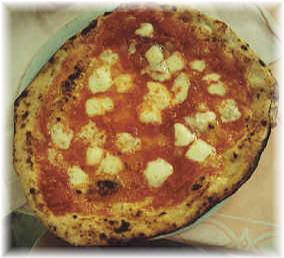 © Kantosschule Wiedikon-Zürich |
The pizza is a very colourful dish,
which is also seen as a symbolic display of the town
--------------
with its ash black edge, scorched
by hot streams of lava from Mount Vesuvius,
it is riddled with bright islands of mozzarella
representing the town's districts
on top of a deep red tomato surface,
which at the same time typifies the
life and passion of its residents.
There are many stories circulating Naples concerning the invention of the pizza.
They are generally nice to listen to, but mainly arise
from the lively fantasies of those telling the story, thus leaving them quite unbelievable.
If one would like to know about the true origin of the pizza,
it is necessary to travel back into distant history.
Early Palaeolithic Age ( 45.000 - 9.000 before Christ )
The people of those days didn't know anything about agriculture, but
during excavations, one has found grinding stones from the early Palaeolithic Age.
Our Stone Age ancestors used these grinding stones to grind wild cereals and
roots rich in starch - this enabled them to eat the pulp or bake flat bread on hot stones.
Findings indicate that these stones were quite commonly placed in a pit together with
hot glowing ashes, which served as what could be called, the forerunner of the oven.
 © www.blumammu.de |
It has been proven that flat bread - without doubt the original type of bread -
was known in the Near East and Mediterranean area at least
as far back as the Neolithic Period ( 5.600 - 2.000 before Christ ).
In "old" Egypt, there was already an economy resting on the division of labour.
The professional Egyptian bakers discovered the effect of yeast, and as from that day,
the fermentation of dough was no longer a coincidental happening.
The Greek and inhabitants of the Near East adopted yeast for baking,
because it made bread more "airy" and lighter.
 |
 |
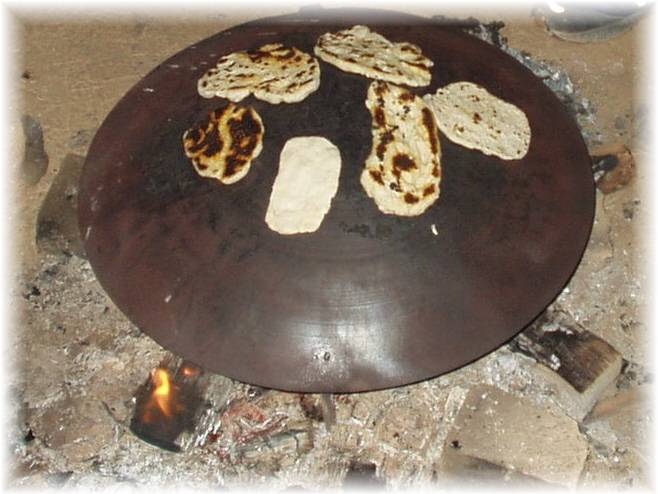 © Wikipedia |
From times of the Persian King
Darius the Great ( 549 - 486 before Christ ),
there are reports that signify
that his soldiers baked flat bread
on their shields after battles,
consuming it together
with cheese and dates.
Take a look at
the photo from this day and age !
 |
 |
 Herodot |
Herodot of Halikarnassos
( 484 - 425 before Christ ),
Greek historian
and geographer,
reported after his travels,
that the people of Babylon
ate flat bread as well.
Within areas, today known as Italy, it is proven that the Etruscans ( approx. 800 before Christ )
have been the first to bake flat bread on hot stones, and consume it together with various toppings.
A few hundred years later,
again the Greek ( - The Italians should please forgive us ! - )
- at that time settling in parts of Southern Italy and Sicily -
causing a further step in the development of the pizza as we know it today :
They went a little further than the Etruscans, and topped their flatbread,
named "Planctunos", before it was baked, and not afterwards.
The Romans adopted recipes and methods of preparation
from the Etruscans and Greek, and named these simple meals : Panis focacius
( Latin : "panis" = bread - "focus" = oven / fire )
 |
 |
 Cato |
Marcus Porcius Cato Censorius, named
Cato the Elder ( 234 - 149 before Christ ),
the well known Roman commander, historian,
author, and statesman, not only mentioned
- apparently at the end of a speech in front of the senate -
his belief "Ceterum censeo Carthaginem esse delendam !"
( Incidentally, in my opinion, Carthage should be destroyed ! ),
but also reported in a script handed down,
about a dish described as a "flat round pieces of dough
with olive-oil, spices and honey, baked on a stone -".
Over the course of the next few hundred years, this dish was made known to the whole of Italy
and even across to Gaul, this being due to the numerous Roman campaigns,
whereby their customs were subsequently adopted within the conquered areas.
Regionally, there were differing variations, of which some even exist today
and are still prepared as in ancient days ( without tomatoes ).
These are the "Pizza pugliese" from Apulia, the "Pitta inchiusa" from Calabria
and the "Schiacciata" from the Tuscany, the area were the Etruscans had settled.
 |
 |
 Focaccia © Foodcollection Italy |
These means
of heating sandwich bread
ultimately developed
- also etymologically -
into a speciality
from Italy today known as
Focaccia,
or from the Provençe area known as
Fougasse
or from central France known as
Fouace
( now as a yeast cake ).
In the Naples dialect, around the year 1000, the words "picea" and "piza" were used,
being two earlier versions of the word "Pizza" to be used later on.
The origin of these words has not been absolutely clarified,
however, we do know of three different theories.
1 )
In Neapolitan dialect, the word "picea" meant something like "push" or "jerk"
and could have something to do with the sudden movement made by the baker
when jerking the shovel to slip the flat bread into the oven.
2 )
From 827 - 1091 the Saracens reigned in Sicily; and over an even longer period in Sardinia.
During the 9th century, in addition to this, there were Emirates in Taranto, Bari and Brindisi ( Apulia ).
This means that we can take it that there was Arabic influence in the remainder of Southern Italy,
this providing the theory of the "Pizza" deriving from Arabic.
( Arabic : "pita" = bread / flat bread )
3 )
The Lombards, a northern Germanic people, arrived during mass migration
at around the year 500 in what is known today as Northern Italy ( Lombardy ),
they also conquered areas in central and southern Italy.
The capital city of Lombardy, Pavia, was taken by Karl the Great in 774, but Benevento
in the area of Campania close to Naples remained under Lombard authority
right into the eleventh century.
In the Lombardian language "bizzo" means more or less "a piece of bread".
This means that "Pizza" could derive from the Germanic-Lombardian "bizzo".
By the way :
In the German language of our days, there is still the expression "ein Bissen Brot"
which means exactly the same as "bizzo" !
If this third theory does actually happen to be correct, it would mean that the name
of the - following Spaghetti - second Italian "national dish" has Germanic roots !
( - I hope the Italians will pardon us for a second time ! - )
It should however, be understood that the "picea" of those days was,
especially in the region of Campania and Naples, a simple meal for
farmers and poor day labourers for several centuries.
 |
 |
 © Foodcollection Italy |
Within the
poorer households
of those days,
due to the lack of
better ingredients,
the bread was mainly
coated with onions,
a few olives,
a little oil or bacon,
and a few spices.
- Or even sometimes without toppings ! -
Things remained unchanged for the next few hundred years.
There were signs of definite change during the year of 1522 :
After the discovery of the "new world" by Christopher Columbus and others,
the returning seafarers brought the first tomatoes from far countries to Europe.
The seeds of the plant came from Middle and South America first to Spain, later to Naples,
which since 1422 had belonged to the Spanish crown and was known as the
"Kingdom of Naples".
 |
 |
 pomo d'oro |
The first type of tomato showed a yellow-gold colour.
(The Italian name for tomato today - "Pomodoro"
is made up from pomo d'oro - meaning "Apple of Gold" ! )
Botanically a nightshade, they were considered poisonous,
and were only used as exotic plants for decorating gardens.
They were not seen as a food.
Nevertheless, that's life :
Somehow, the first Campanian or Neapolitan had turned a blind eye during times of need,
and used the tomato to top his flat bread. He survived, word spread, and poor people
around the Naples area began to use tomatoes for topping their formally dry dough bread.
 © Foodcollection Italy |
In the 16th century the bread dish, now together with its tomato topping,
became a very popular speciality in the Naples area and Campania.
Quite in opposite to the rest of Europe, where the tomato was first accepted as food
during the 18th century, and up to this time was only seen as a garden decoration.
Those, such as many poor city residents, who did not have their own oven,
prepared the dough at home, and took it to the bakers to be baked.
In the course of time, the pizza bakers ( "Pizzaioli" )
isolated themselves from the classic bakers, forming their own guild.
They then only produced pizzas, and the corresponding dough.
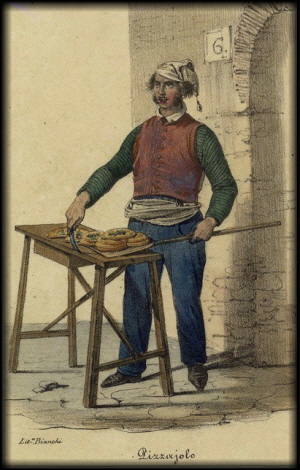 PIZZAIOLO Lithography / approx.1830 |
During the 17th century the pizza
( now with tomato and more or less as we know it today )
became more widespread, and more famous.
Visitors to the town reported how they had seen a delicious dish
being prepared within the poorer quarters in small bakeries, this being the
PIZZA.
One would only purchase the pizzas in these bakeries.
They were either taken home
or folded - "a libretto" - ( " like a little book " ) and eaten out of hand on the street.
Nobody drank wine with the pizza, and nobody sat down at a table to eat one.
There were travelling street-traders
who sold freshly baked pizzas to people down the lanes and in the houses.
They transported the pizzas in small barrel-shaped copper containers with numerous levels
and glowing charcoal in a compartment on the bottom, thus keeping the pizzas warm.
 |
 |
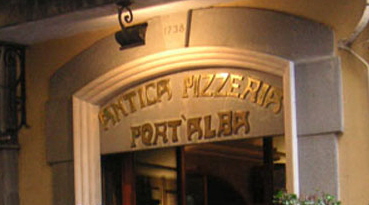 © Antica Pizzeria Port' Alba |
The first real pizza parlour with seating
( Italian : "pizzeria" )
was opened in Naples during 1830,
this parlour was named "Port' Alba".
Contemporaries saw it
as a special local feature
with no "big future".
- However, it still exists today ! -
 |
 |
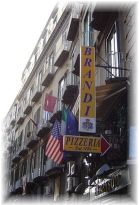 © Pizzeria Brandi |
The first
pizza delivery on demand
was made in 1889
by Raffaele Esposito,
a well known pizza baker
( "Pizzaiolo" )
and owner of the pizza parlour
"Pietro il Pizzaiolo",
today known as
"Pizzeria Brandi",
still to be found in Naples.
Those who ordered were the Italian King Umberto I and his spouse Queen Margherita,
who lingered around her summer residence "Capodimonte" near Naples,
and during the evening sometimes enjoyed some of the local famous speciality,
in those days described as "poor peoples food".
Since dining out together with the "simple folk" in Raffaele Esposito's pizza parlour
is not accepted for the royalties, they had the pizzas brought to them into their residence.
Raffaele Esposito baked three pizza variations,
the first was known as "Mastunicola", spiced with pork fat, cheese, and basil;
the second was known as "Marinara", spiced with garlic, oil and tomato.
 |
 |
|
|
With the ingredients
basil, mozzarella, and tomato,
the third variation showed
the colours of the Italian flag
( green - white - red ).
Apparently, the third one was the queen's favourite,
which was the reason for Esposito giving it the name "Pizza Margherita".
Right up to the present day,
the "Pizza Margherita" is worldwide the most popular and ordered pizza variation.
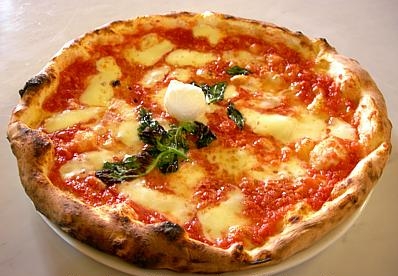 Pizza Margherita |
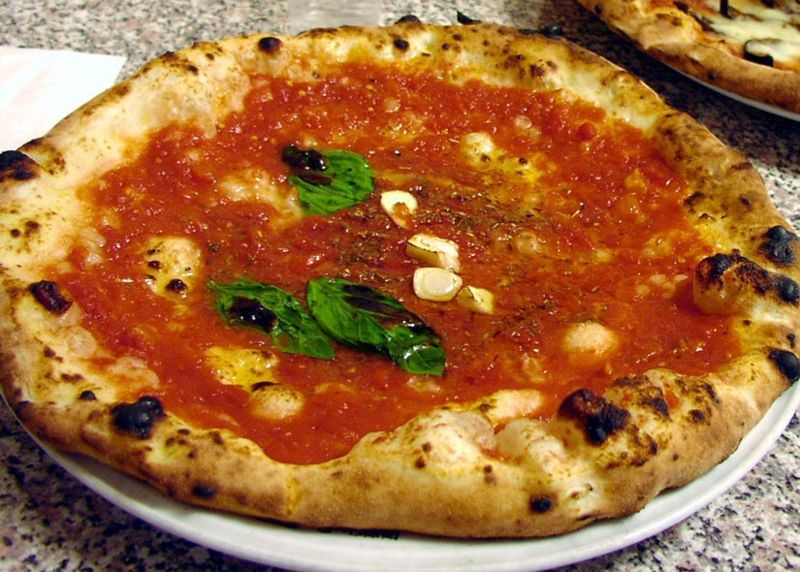 Pizza Marinara |
The
"Pizza Margherita"
and the
"Pizza Marinara"
are the only pizza variations
accepted by the
traditional conservative
"Associazione Verace Pizza Napoletana"
as
"verace pizza napoletana".
Following this, up to the turn of the 20th century, Italian emigrants
took the pizza across the Atlantic to America. This is where the pizza got a
slightly different taste due to American cheese being used instead of mozzarella.
The pizza was however, still made in a similar style to that of the Neapolitan style.
The next stage was that in 1905 In Manhattan's "Little Italy",
the "new worlds" first pizza parlour,
"Lombardi's",
was opened by the Italian immigrant Gennaro Lombardi.
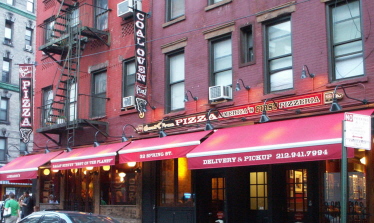 Lombardi's - New York © Wikipedia |
To this day, something special differentiates this pizza parlour to all others around the world :
The pizza ovens are not fired with wood, but with coal.
How is this done ?
- And how do they manage to bake pizzas with fire from coal without this affecting the taste ? -
We don't know ! - But it works !!
Right into the twenties, further pizza parlours were opened in other towns on the east coast
- mainly by Italian immigrants -, the customers consisted mainly of Italian immigrants as well.
At first - the other areas of America generally remained "pizza free" !
In 1943 the Italo-American Ric Ricardo and his partner Ike Sewell, opened up
a pizza parlour in their home town of Chicago, they named it "Uno's Pizzeria".
They were worried that they would not have all that much success with the "classic"
Neapolitan pizza, because, in general throughout the middle-west part of the country,
their fellow citizens preferred very savoury and hefty meals.
 |
 |
 Chicago-Style-Pizza © Wikipedia |
For this reason,
they created a very
free interpretation of the
Italian Neapolitan pizza,
which was prepared
in a frying pan and
had a thick base.
The spices
were more savoury
matching the average taste
of the middle-west
of the country.
The first "Deep-Dish Pizza"
The products today offered by the fast food chain "Pizza-Hut" match this
Chicago-Style-Pizza or American-Style-Pizza.
Of course, beside this style of pizza, the Manhattan-Style-Pizza,
which is similar to the original Italian pizza, is still offered, but mainly along the east coast.
We got to hear about a funny story, which we do not want to keep a secret,
but we cannot guarantee that the story is actually true :
According to the story,
towards the end ot the second world war at around about 1944 / 1945,
some of the American soldiers landing in the south of Italy who knew of the pizza
from America, were happy to see that pizza parlours existed in Southern Italy.
Because they did not know anything about the origin of the pizza, they thought that
the Italians, who were serving in these pizza parlours the "original American" dish,
had set up the restaurants especially for the victorious liberators.
Is there any truth in this ? - We don't know !
In 1948, the Italo-American Frank A. Fiorello from Massachusetts
brought the first prefabricated pizza baking mix called "Roman Pizza Mix" onto the market.
If one thinks about the fact that pizza dough only consists of flour, yeast and a little salt,
which is mixed together with a little water and maybe a little olive oil, the question must be :
Did the world really need a "Roman Pizza Mix" ??
During the last century at the end of the 50s, the fast spreading about of the pizza began in the USA,
with it developing to a fast food just as much loved as the hamburger and hot-dog.
Significant for the fast success of the pizza amongst American consumers, was supposed
to be the unintended advertising by Dean Martin when he sung the song "That's Amore".
The first verse started with :
"When the moon hits your eye like a big pizza pie, that's amore !"
So you can say today that :
Pizza has in the meantime become as much American as baseball or apple pie !
1957 was another special year for the pizza :
The American company Celentano Brothers Inc. ( Owners : two brothers of Italian descent )
claims to have produced the very first deep frozen pizza.
However, the "Nevada Inventor's Association" names Mrs. Rose Totino as the
inventor of the "Frozen Pizza". - Mrs. Totino, daughter of Italian immigrants,
and her husband ran a pizza parlour in Minneapolis. Within this business, and
at the same time as the Celentano Brothers, she sold her first deep frozen pizzas.
 |
 |
 Rose Totino |
She was given a US patent,
which years later,
she sold to the Pillsbury Company
for the sum of 22 million dollars.
Right up to the present day
the pizzas marketed by Pillsbury
are the markets leading brand
of deep frozen pizzas
in the USA and bare the name
"Totino's".
 |
 |
 "Frozen Pizza" © Wikipedia |
Never minding
who the true inventor is :
For many years now,
the conquest of the
Deep Frozen-Pizza
within home freezers,
is a worldwide
success story.
 |
 |
 Pizza-Hut - Nr. 1 © Sanjay Acharya |
On the 15th of June 1958,
Frank and Dan Carney,
both students at the time,
opened a pizza parlour
on the grounds of the
Wichita State University in Kansas.
It was named "Pizza-Hut"
because of the small building
used to accommodate it.
The "victory" of the pizza within the rest of Europe at this point in time, meaning during the 50s,
had only very gently commenced.
In 1948 it was only available in Italy - mainly in the south - and Marseille -
but was unknown throughout the rest of Europe.
 |
 |
 "Poor person's meal" ?? © Foodc. Italy |
The pizza was just an unspectacular
"poor person's meal" :
A little simple yeast dough,
a few tomatoes,
a little cheese and spices,
that was all !
The pizza could not be found
in cookery books
- not even in Italy.
The first pizza parlour in Germany was opened in 1952 in Würzburg in Bavaria.
The first in Sweden in 1958 in Stockholm.
And now we can state : There is no other dish that has in this short time,
spread in such a manner as the pizza with all its different variations.
However, the development carries on right up to the present day.
 |
 |
 Brand-name Article |
From 1990 - 1995 well known
kitchen equipment producers
introduced interesting accessories
for their electric and gas ovens
to the market : the
PIZZA STONE and BREAD BAKING STONE
These ceramic slabs are preheated in the home oven;
subsequently the pizza is placed directly onto the hot stone and baked.
Advantage :
This way of preparation leaves the pizza with a crispy pizza base,
which means that the pizza is very close to the Neapolitan original.
Disadvantage :
The PIZZA STONES / BREAD BAKING STONES provide by the brand name manufacturers
with prices ranging from EUR 80.00 to EUR 120.00 are very expensive !
2004 is the final noteworthy year in the history of the pizza :
On the internet at the address www.3-2-1-pizza.eu
PIZZA STONES and BREAD BAKING STONES
were put on offer at very reasonable prices.
At EUR 42.90 for such a stone, pizza fans are able to make use
of the advantage of crispy home baked pizzas without the decisive disadvantage of paying an fortune.
 Our PIZZA STONE |
In the meantime,
more than 25.000 purchasers and "Home-Pizzaioli" throughout the whole of Europe,
have made this positive experience.
Another thing that happened in 2004 is that the PIZZA SCISSORS were invent and presented
by Manfred and Loretta Krupka from Germany.
 |
 |
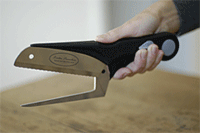 PIZZA SCISSORS in action |
In the past, these two "pizza-lovers"
had always become annoyed
when using a knife or pizza-cutting wheel,
because afterwards the topping looked terrible
and more than anything else resembled a battlefield.
The use of PIZZA SCISSORS
has now made this a thing of the past.
And finally, something about pizza consumption :
The amount of pizza consumed around the world is on the increase.
Top consumers are the USA, where an annual per capita average of 12.5 kg is devoured,
Italy with 5.4 kg taking second and Germany with 3.8 kg taking third place.
Now 2 additional figures :
The Fast Food chain "Pizza-Hut" has a worldwide work force
of 300.000 employees in approx. 34.000 ( !! ) vending points.
© Hansi Eisele -2007
ANY QUESTIONS / ADDITIONS or CORRECTIONS ??

